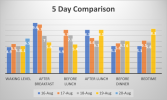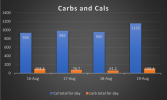Hello
@Mareen,
For you as a Type 1 there is no particular limit on what you eat, but of course you must take enough insulin to go with the carbohydrates you are eating. This really means you need to be carb counting and I gather from a different thread that you haven't done a DAFNE course so probably aren't yet carb counting. Are you even carb estimating, eg from the nutritional info on backs of packets? If not, may I suggest that you start at least looking at how many carbs you're consuming daily?
[NB Type 2 diabetics are at a different starting point, particularly if they are on oral meds, such as Metformin. They, usually, produce enough insulin but their bodies resist this; so their viewpoint is often to have low carb meals and thus allow what insulin is working to do its thing effectively. So this thread was started by a T2 and you might become misled by seeing carb nos that T2s are trying to stay below!]
Are you on fixed insulin doses? If so did the person defining those doses tell you what they assess (guess really) how many carbs each fixed dose might be covering for each meal? If not, go back to that person and seek guidance. Otherwise you are taking insulin with a thick blindfold on and blindly trusting that any one meal is being covered by your insulin dose - regardless of the many other factors that can come into play; eg the recent hot weather.
In his book "Think Like a Pancreas" (which I have found very helpful) the author Gary Scheiner describes Diabetes as complicated, confusing and contradictory. I can only agree with that appraisal - BUT it doesn't have to be like that always. His book also provides a lot of information about carbohydrates and carb counting, leading to insulin dosing. His book was my start point for carb counting and dosing and, once I got Libre 2, I could get a much better insight into what was (and was not) working for me.
One piece detail in his book was to try and consume at least 30 gms of carbohydrates with every meal for which you take a bolus dose. This excludes snacks which don't specifically need insulin.
Our bodies need glucose, the brain in particular demands only glucose. That glucose normally comes from the carbohydrates that we've eaten and which, during digestion and metabolism, get converted into glucose. If we don't eat sufficient carbohydrates, ie less than 30 gms, then in order to meet the demand for glucose our bodies will convert proteins and fats into glucose. There are reasons why we might not eat sufficient carbs, perhaps because our daily routines are very irregular or just by choice, eg for health reasons.
Importantly, in general, if each main meal for which we take a bolus is greater than 30 gms of carbs then that will usually be sufficient so that our bodies don't need to convert proteins and fats into glucose.
The relevance of this is that 3 x 30 gm carb meals is still pretty low to meet many peoples desires to not eat too many carbs; in practice people usually eat a lot more carbs across the day. But, significantly, one can determine reasonably accurately the insulin to carbs ratios that works for each of us, albeit the ratios might be different for breakfast lunch and dinner. Hence arriving at the size of the bolus dose is "doable". Whereas the ratios for converting proteins and fats are different, usually lower (eg insulin to carbs might be 1unit insulin for every 10 gms of carbs); but not only very different ratios for proteins, varying for each meal but also varying with the type of protein; fat conversion is even less efficient. So if one can have 30gm minimum carbs per meal then bolus calculations are not only a lot more straightforward, but also this removes one of the many complication factors in managing D. I hope that hasn't added to the confusion, bottom line: try and ensure at least 30 gms of carbs in any one meal thus remove one 'variable' of proteins or fats being converted into glucose at some unfathomable conversion rate.


